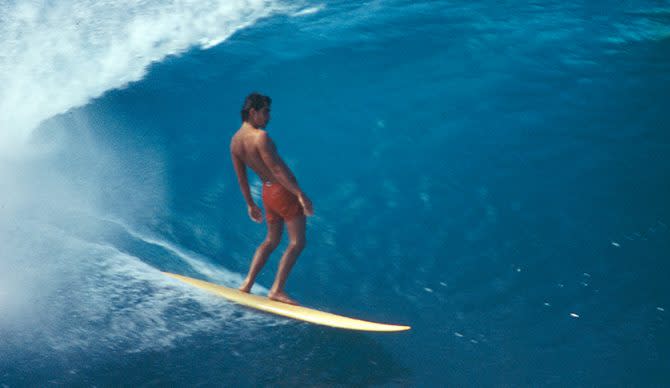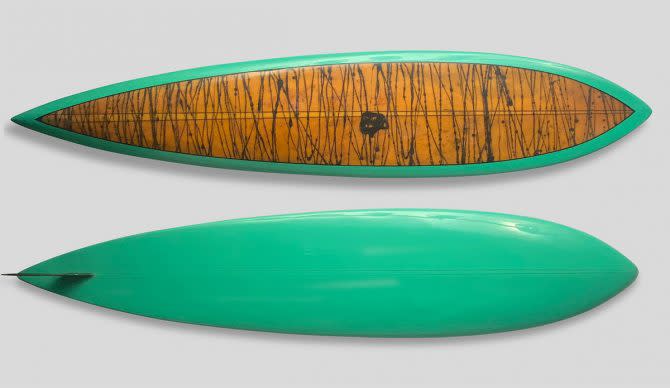The Surfboards That Allowed Us to Ride the Tube

- Oops!Something went wrong.Please try again later.
In case you haven’t noticed lately, surfing seems to have become all about the tube. Never before in surf history has a specific aspect of the surfing experience become so elevated as to establish a rigidly standardized, all-or-nothing benchmark against which all other applications of our wonderfully diverse sport are deemed insignificant.
Take high-end surf travel, for example. How many exotic surf resorts or boat charters can you name that deposit clients in fun, easy-to-ride beachbreaks? Would there be a Tavarua, or a single Indonesian boat trip, if their associated waves didn’t barrel. Think anyone would make the trek to Namibia’s Skeleton Bay to do cutbacks? Then consider the big wave arena: tube riding in 50-foot waves is now the standard of performance at spots like Peahi and Maverick’s, with any other type of ride considered pedestrian; 100 foot or not, Nazaré has yet to shake off its mushburger rep. Crumbly, mushy slabs? Good luck, Nathan. And don’t even get me started on the contest scene.
Judging by online comment culture, pro surfing fans would gladly trade Lower Trestles, one of the world’s best high-performance waves, for a monochromatic, pull-in-and-go-straight tour at spots like The Box, Teahupo’o and Pipeline. Still, for all our current obsession, this love affair had to start somewhere. It did, at a specific point in time, at a specific spot, and with some very specific surfboards.
“It was early spring in Hawaii, 1968, and I had a high school friend named Howard Fukushima, whose grandfather allowed us to use one of his commercial spaces in Wahiawa to build our boards,” recalls Gerry Lopez, talking about one of his first sawhorse shaping attempts. “The first one we made there was my own, the second was Howard’s and the third one was for a friend of ours, a really good surfer named Don Green. All three were basically my version of the first short ‘mini-guns’ that Dick Brewer designed for us that winter. And we were riding them at hollow spots like Cannons, on Kauai, which we had all to ourselves back then, but with the flat rocker and the turned-up rails of the time, they just weren’t working that well. Still, I’d have to say, these were the boards that got me thinking.”
What young Gerry was thinking about wasn’t empty Kauai tubes, but a more strenuous theater of combat on Oahu’s North Shore.
“There were a lot of great surfers who who surfed the Pipeline before me,” says Lopez, referring to that period in the mid 1960s when Pipeline first began to be seriously surfed. “But they weren’t having a lot of success, because their equipment was holding them back.”

Lopez wasn’t just talking about the heavy, straight-rockered longboards being ridden by early Pipe standouts like Butch Van Artsdalen, John Peck, Stanley Parks, but even the first “shortboard” pocket-rockets in use by transition stars like Jock Sutherland and Tom Stone. These boards, while decidedly shorter and narrower, still featured the period’s characteristic “s-deck” foil and rail line, along with a relatively standard outline – basically the same board they’d be riding at Ala Moana.
“But the tube at Ala Moana was different,” says Lopez. “It was friendly, forgiving. Pipeline, on the other hand, was fierce, it could hurt you. So [the contemporary] surfboards were a big obstacle that had to be overcome, and I went through a lot of boards in the process of doing that.”
Gerry was perfectly positioned to take on this sort of experimentation, having honed his shaping chops under the mentorship of legendary surfboard designer Dick Brewer. By 1970, Lopez, who’d proved to be a natural with a Skil planer, had been for some time staring down at plenty of virgin blanks, dreaming of freeing the perfect Pipeline design hiding within…and at some point thinking back to those early mini-guns of his.
“Eventually, we tossed around the the idea of a board with a nine-inch tail, measured a foot up from the tail,” he recalls. “That’s what a lot of Waimea guns had at the time, but none for any of the other North Shore spots. And I thought, well, I’m going to try that.”
Hard to imagine today, but there was a time when top North Shore surfers didn’t need a big garage to store their vast quivers. In 1970, for example, a 7’6” Sunset Beach squaretail and a 9’0″ Waimea gun would suffice, the shorter board being ridden at all other breaks, from V-Land to Haleiwa. What Lopez had in mind was a board made especially for riding at the Pipeline, and, more specifically, riding in the tube.
“I outlined this board with a nine-inch pintail,” he says. “Then I looked at it, and went ‘Wow, nobody’s got a board like this.’ So, I went ahead and shaped it.”
Almost as important as the tail dimension, however, were several other crucial design elements that Lopez incorporated into his radical tube-shooter.
“The boards we were riding previously had a down rail in the tail, transitioning to a 50-50 rail in the center, then turning up in the nose with a slight belly. And they just didn’t work in the tube. On the “Coral Cruiser” [as this breakthrough board would come to be known] I put a down rail throughout. Not like those early downrailers that were so flat you could only go straight, but a softer down rail that gave you a lot of control in the steepest part of the wave. Then I added tail rocker, way more than in those earlier mini-guns”
The result of Lopez’s brainchild was an eight-foot, wickedly narrow, but loose-turning pintail that turned out to be a complete game-changer.
“I took it out on the next good day at Pipeline,” remembers Lopez. “And right from the very first wave, I thought, hey, I’ve really got something here.”
No arguments there. Riding that very first Pipe board, Lopez electrified the surfing world with his ability to now take off behind the peak at Pipeline, pull off the bottom and up into the barrel, reset his line with the foam ball licking his heels and then get spat out onto the shoulder in a shower of spray, time after time, surf movie after surf movie, magazine cover after cover. Virtually the same formula used to win every Pipeline Masters since the inaugural event; the same ride so assiduously replicated today on virtually every legit ride at Teahupo’o…or Greenbush or The Cave or Big Rock or any other of the world’s cherished hollow haunts. In short, Pipeline gave us the wave, Gerry Lopez gave us the boards, and those boards gave us the tube, the fruitful relationship between the three being the genesis of today’s barrel obsession, a full five decades on.
It would be great to be able to say that this seminal modern tube shooter has a place of honor in some surfing museum, or better yet, in the rafters of Gerry Lopez’s shaping room, but we’ve no such luck – throughout the early ‘70s this Pipeline master’s innovation continued apace and that first Coral Cruiser was quickly relegated to the “seconds” heap.
“Actually, a lot of guys rode that board after I’d moved on, design-wise,” remembers Lopez. “And I was never really sure what happened to it, or where it ended up. Just recently, though, Robbie Burns, a good surfer, he went on to start Local Motion, told me that back in the early ’70s he had borrowed it, and broke it. He said he felt so guilty that he chopped it up into little pieces and stuffed it in a dumpster, so that nobody would know. He tells me this 50 years later! And I said, ‘Oh, you dirty buggah!'”
History may have lost the Coral Cruiser, but luckily, we do have at least one of its predecessors. “Number Three” in the series that Lopez shaped on those Wahiawa sawhorses way back in ’68 has recently turned up, having somehow avoided any dumpster burials to emerge virtually intact and beautifully restored, and will now go up on the block at the 2024 California Gold Surfboard Auction.
“It’s incredible that after all these years, Don somehow managed to hang on to it,” says Lopez. “Looking at it now, it’s easy to see how this board influenced that first Coral Cruiser, especially the tail dimensions. I’m kind of jazzed that it’s still around.”
Bidding on 48 surfboards and additional memorabilia in the California Gold Surf Auction ends on Saturday, April 20th, at 5pm PST. For more information go to TheVintageSurfAuctions.com.
The post The Surfboards That Allowed Us to Ride the Tube first appeared on The Inertia.

